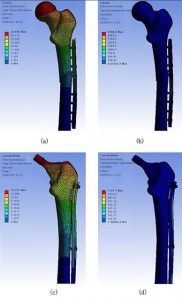The finite element method (FEM) was created to solve structural analysis issues in the fields of mechanics, civil engineering, and aeronautical engineering. Turner is credited with inventing this procedure, which he published for the first time in 1956. In 1967, Zienkiewicz released “The Finite Element Method in Structural and Continuum Mechanics,” a book that set forth the method’s mathematical foundation. Around the same period, other important contributions to the development of FEM occurred.

Pic : 3D finite analysis with Ortho-Bridge System (OBS)
Despite its complexity, finite element (FE) simulation has shown to be particularly useful in studying the behavior of any physiological unit. It has since evolved into a valuable tool in the fields of orthopedic surgery and traumatology, assisting surgeons in gaining a better grasp of biomechanics in both healthy and pathological settings. The biomechanical changes that occur following prosthesis or osteosynthesis implantation, as well as the biological reactions of bone to biomechanical changes, may be determined via FE modeling. It also offers the benefit of forecasting changes in the stress distribution surrounding the implanted zones, allowing for the avoidance of future diseases caused by improper prosthetic placement or fixation. The recovering force-displacement and angle-moment curves that describe the mechanical behavior of the splint throughout the whole range of motion are also provided by simulation, allowing us to anticipate the behavior of orthopedic splints used to repair abnormalities.






